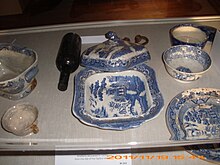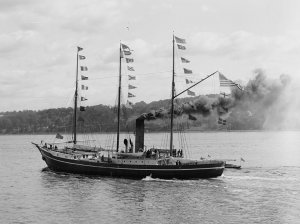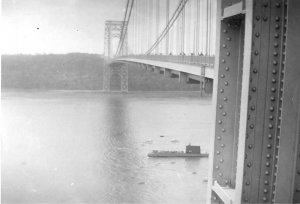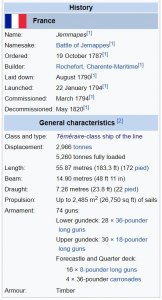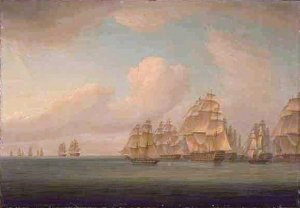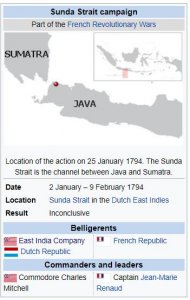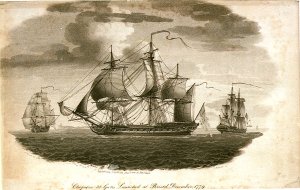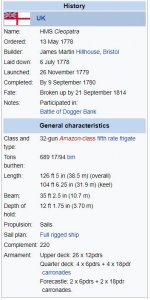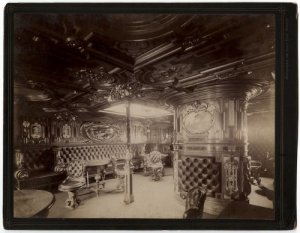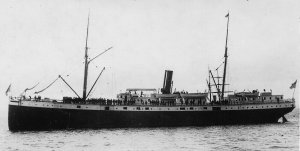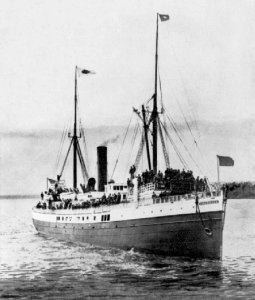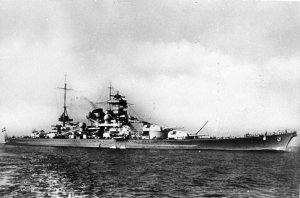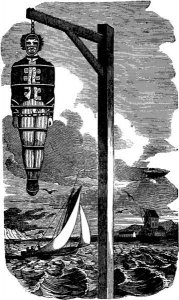Today in Naval History - Naval / Maritime Events in History
21 January 1796 - pilot ship Cartier, a brig launched in 1787 for the Bengal Pilot Service, was captured by French privateer corvette Émilie, captained by privateer Robert Surcouf.
Cartier was a brig launched in 1787 for the Bengal Pilot Service as a pilot ship operating at Balasore Roads. The French privateer Robert Surcouf captured her, and then used her to capture the East Indiaman Triton on 29 January 1796. The British Royal Navy subsequently recaptured her.
The brig Cartier operated in Balasore roads, in the Indian Ocean. On 21 January 1796 the French privateer corvette Émilie, captained by Robert Surcouf, captured her.

Boarding of the Triton by the French corsair Hasard(ex-Cartier) under Robert Surcouf. Painting by Léon Trémisot.

Surcouf had the four 6-pounder guns of Émilie mounted on Cartier, renamed her Hasard, (or Hazard), and transferred aboard with 23 men. Two days later, Hasard encountered the East Indiaman Triton, with a 150-man crew and 26 guns; despite the overwhelming superiority of Triton, after haranguing his men, Surcouf approached under a British flag, before hoisting French colours at the very last moment and launching a violent assault. In the ensuing 45-minute battle, Triton suffered 5 wounded and 10 killed, including her captain, Captain Burnycat (or Burnyeat), and the first officer, Picket; The prisoners were transferred to Diana, which Surcouf released against a 30,000 rupee ransom.
Transferring to his new prize, Surcouf left ten men on Hasard as a prize crew and returned to Île de France (now Mauritius), on Triton. During the journey back, in the month of February 1796, Hasard encountered the 74-gun HMS Victorious, which recaptured her.
Émilie a French corvette-built privateer based in Île de France (now Mauritius). She is mostly known as one of the ships captained by Robert Surcouf.
In early 1795 she was renamed to Émilie, which might raise your eyebrow since she was then under command of young Robert Surcouf; she was armed with only 4 6-pounders cruising from August 1795; in January 1796, after she had captured Cartier, Surcouf transferred to his prize, leaving Émilie in command of Jean Croizet. (more details at Robert Surcouf#Cruise of Émilie and capture of Triton). She returned to Mauritius in March 1796 and was renamed Modeste again. In August 1796, armed with 20 guns, she cruised under Claude Deschiens, who died in battle on 10 September 1796; command passed to Jean-Marie Dutertre and she returned to Isle de France in June 1797. Dutertre went on another cruise from late 1797 or early 1798, and sailed until April 1798 (again with 20 guns). Eventually captured by the Royal Navy but the circumstances are murky: either in March 1797 near Visakhapatnam by the 32-gun HMS Fox, or in April 1798 by the 32-gun HMS Cleopatra

Career
Émilie was originally the merchantman Lafayette, arrived at Île de France from Bordeaux in July 1792. In 1793, she was commissioned as a privateer corvette and conducted a campaign under Jean-François Malroux during the year.
In September 1793, she was renamed Île de France and cruised until April 1794 under Léonard-Julien Quiroard.
Around May 1794, she was under Louis Levaillant, carrying the name Modeste. She notably captured the Dutch East India Company ship Hootluyce, with Joachim Drieux leading her boarding party.
In August 1795, Modeste passed under the command of Robert Surcouf, who renamed her Émilie. Governor Malartic had refused to provide Surcouf a lettre de marque and ordered Émilie to go to the Seychelles to purchase tortoises as food for Île de France. Upon arrival at Mahé, she encountered two large British ships and fled hastily, cutting her anchor. Arrived a Bago, Myanmar, Émilie encountered the British merchant Pinguin; she approached without hoisting colours and when Pinguin fired a warning shot, Surcouf took pretext of it to fire a three-shot broadside that induced Pinguin to surrender. Surcouf took supplies needed for Émilie and sent Pinguin to Mauritius under Péru, one of his officers. On 19 January, Émilie captured the pilot ship Cartier, along with two rice-loaded merchantmen she was guiding; Surcouf transferred to Cartier, which he renamed Hasard, taking all the guns off Émilie and leaving only 23 men aboard under Jean Croizet, who returned to Île de France with the two prizes.
When she returned to Île de France, Émilie was renamed back to Modeste. In August 1796, she set out for another campaign under Claude Deschiens, this time armed with 20 guns. She captured Princess while Princess was at anchor in Delagoa Bay. Although Modeste captured Princess, Butterworth was able to fend off Modeste. Modeste did capture Good Intent two days later.
Deschiens was killed in action on 10 September. As Deschiens was preying on British whalers, two heavily armed whalers attacked Modeste. Deschiens managed to repel them but was injured in the battle and died of his wounds the next day. Jean-Marie Dutertre took command and continued the cruize. Still, Modeste returned to Île de France within the month.
The same month, she set out for another campaign under Jean-Marie Dutertre. Apparently HMS Fox captured Modeste near Visakhapatnam in March 1797

Boarding of Triton by the French corsair Hasard. Engraving by Ambroise-Louis Garneray
Robert Surcouf (12 December 1773 – 8 July 1827) was a French privateer who operated in the Indian Ocean between 1789 and 1801, and again from 1807 to 1808, capturing over 40 prizes, while amassing a large fortune as a ship-owner, from both privateering and commerce.
Surcouf started his career as a sailor and officer on the slave ships Aurore, Courrier d'Afrique and Navigateur. Having risen to captain, and in spite of the prohibition of slave trading by the National Convention in 1793, he engaged in the business himself as a captain on Créole. He then captained the merchantman Émilie, on which he engaged in commerce raiding despite lacking a letter of marque. He preyed on British shipping, capturing the East Indiaman Triton, before returning to Île de France in the Indian Ocean, where his prizes were confiscated. He then returned to France, where he obtained prize money from the government.
Returning to the Indian Ocean, Surcouf captained the privateers Clarisse and Confiance, raiding British, American, and Portuguese merchantmen. He captured the East Indiaman Kent on 7 October 1800. Returning to France, he was awarded the Legion of Honour and settled as a ship-owner.
He briefly returned to the Indian Ocean in 1807 on the custom-built Revenant before returning to France. There, he armed privateers and merchantmen. His privateers led successful campaigns against the British in the Indian Ocean and disastrous ones in the English Channel, except for Renard. This cutter achieved fame in her very costly victory over HMS Alphea on 9 September 1812 which exploded after repulsing French attempts at boarding. There were many casualties. After the Bourbon restoration, he organised fishing expeditions to Newfoundlandand amassed a considerable fortune. He died in 1827 and is buried in a graveyard at Saint-Malo.
Cruise of Émilie and capture of Triton

Cruise of Émilie: from Port-Louis (Mauritius) to the Seychelles via La Réunion, on to Sumatra, the Gulf of Bengal, and return to Port-Louis.
In the spring in 1795, Surcouf took command of the 180-ton, privateer schooner Modeste, renamed Émilie, with a 32-man crew and four 6-pounder guns, armed by Malroux and Levaillant. Governor Malartic refused to provide a lettre de marque and ordered Émilie to go to the Seychelles to purchase tortoises as food for Isle de France.
Émilie departed on 3 September 1795 with a congé de navigation authorising her to defend herself, but not to take prizes as a privateer. The next day, she made a port call at Saint-Denis before cruising to Mahé. At Sainte Anne Island, two large British ships chased him, but he was able to evade them by sailing through the reefs, at night.
Surcouf then decided to sail to the Mergui Archipelago to load a rice cargo. On 8 December 1795, while in transit, cruising off the Ganges Delta, Surcouf captured his first prize, the ship Penguin, loaded with lumber, on which he detached a prize crew under Lieutenant Péru before sending her to Isle de France.
On 19 January 1796, Surcouf met the pilot ship Cartier leading two merchantmen, the Russel and Sambolasse, through the Ganges delta. He attacked and captured them, finding the merchantmen to be carrying rice. After detaching prize crews, Surcouf transferred his command, along with his remaining 22 crew members and Émilie's four guns, to Cartier, which (according to Ambroise Louis Garneray) he renamed Hasard. Surcouf then sent Émilie, under Lieutenant Croizet, together with his prizes, to Isle de France.
On the night of 28 January, Surcouf captured the 12-gun Diana, loaded with 6000 bags of rice. The next day, Cartier met a 26-gun Indiaman, Triton, armed with 12-pounders and a 150-man crew; having decided to attack, and recognising only too late the overwhelming superiority of his opponent, Surcouf, feeling threatened and unable to flee, decided to board her with his 26 men. After haranguing his men, he approached under a British flag, before hoisting French colours at the very last moment and launching a violent assault. In the ensuing 45-minute battle, Triton suffered 5 wounded and 10 killed, including her captain, Captain Burnycat, and the first officer, Picket; The prisoners were transferred to Diana, which Surcouf released against a 30,000 rupee ransom.
Surcouf returned to Ile de France with his prizes, where he arrived on 10 March 1796, although Hasard was captured by HMS Victorious on the journey back. As Émilie had been armed as a merchant rather than a privateer, the Prize court seized her prizes and sold them for the benefit of the State, although their capture was declared to be legal. Surcouf returned to France to claim his prize money, and on 3 September 1797, the government finally granted him 660,000 francs, of which he only received 80,000

Statue of Surcouf in Saint-Malo by Alfred Caravaniez, inaugurated on 6 July 1903.
https://en.wikipedia.org/wiki/Cartier_(1787_ship)
https://en.wikipedia.org/wiki/Émilie_(1793_ship)
https://en.wikipedia.org/wiki/Robert_Surcouf
21 January 1796 - pilot ship Cartier, a brig launched in 1787 for the Bengal Pilot Service, was captured by French privateer corvette Émilie, captained by privateer Robert Surcouf.
Cartier was a brig launched in 1787 for the Bengal Pilot Service as a pilot ship operating at Balasore Roads. The French privateer Robert Surcouf captured her, and then used her to capture the East Indiaman Triton on 29 January 1796. The British Royal Navy subsequently recaptured her.
The brig Cartier operated in Balasore roads, in the Indian Ocean. On 21 January 1796 the French privateer corvette Émilie, captained by Robert Surcouf, captured her.

Boarding of the Triton by the French corsair Hasard(ex-Cartier) under Robert Surcouf. Painting by Léon Trémisot.

Surcouf had the four 6-pounder guns of Émilie mounted on Cartier, renamed her Hasard, (or Hazard), and transferred aboard with 23 men. Two days later, Hasard encountered the East Indiaman Triton, with a 150-man crew and 26 guns; despite the overwhelming superiority of Triton, after haranguing his men, Surcouf approached under a British flag, before hoisting French colours at the very last moment and launching a violent assault. In the ensuing 45-minute battle, Triton suffered 5 wounded and 10 killed, including her captain, Captain Burnycat (or Burnyeat), and the first officer, Picket; The prisoners were transferred to Diana, which Surcouf released against a 30,000 rupee ransom.
Transferring to his new prize, Surcouf left ten men on Hasard as a prize crew and returned to Île de France (now Mauritius), on Triton. During the journey back, in the month of February 1796, Hasard encountered the 74-gun HMS Victorious, which recaptured her.
Émilie a French corvette-built privateer based in Île de France (now Mauritius). She is mostly known as one of the ships captained by Robert Surcouf.
In early 1795 she was renamed to Émilie, which might raise your eyebrow since she was then under command of young Robert Surcouf; she was armed with only 4 6-pounders cruising from August 1795; in January 1796, after she had captured Cartier, Surcouf transferred to his prize, leaving Émilie in command of Jean Croizet. (more details at Robert Surcouf#Cruise of Émilie and capture of Triton). She returned to Mauritius in March 1796 and was renamed Modeste again. In August 1796, armed with 20 guns, she cruised under Claude Deschiens, who died in battle on 10 September 1796; command passed to Jean-Marie Dutertre and she returned to Isle de France in June 1797. Dutertre went on another cruise from late 1797 or early 1798, and sailed until April 1798 (again with 20 guns). Eventually captured by the Royal Navy but the circumstances are murky: either in March 1797 near Visakhapatnam by the 32-gun HMS Fox, or in April 1798 by the 32-gun HMS Cleopatra

Career
Émilie was originally the merchantman Lafayette, arrived at Île de France from Bordeaux in July 1792. In 1793, she was commissioned as a privateer corvette and conducted a campaign under Jean-François Malroux during the year.
In September 1793, she was renamed Île de France and cruised until April 1794 under Léonard-Julien Quiroard.
Around May 1794, she was under Louis Levaillant, carrying the name Modeste. She notably captured the Dutch East India Company ship Hootluyce, with Joachim Drieux leading her boarding party.
In August 1795, Modeste passed under the command of Robert Surcouf, who renamed her Émilie. Governor Malartic had refused to provide Surcouf a lettre de marque and ordered Émilie to go to the Seychelles to purchase tortoises as food for Île de France. Upon arrival at Mahé, she encountered two large British ships and fled hastily, cutting her anchor. Arrived a Bago, Myanmar, Émilie encountered the British merchant Pinguin; she approached without hoisting colours and when Pinguin fired a warning shot, Surcouf took pretext of it to fire a three-shot broadside that induced Pinguin to surrender. Surcouf took supplies needed for Émilie and sent Pinguin to Mauritius under Péru, one of his officers. On 19 January, Émilie captured the pilot ship Cartier, along with two rice-loaded merchantmen she was guiding; Surcouf transferred to Cartier, which he renamed Hasard, taking all the guns off Émilie and leaving only 23 men aboard under Jean Croizet, who returned to Île de France with the two prizes.
When she returned to Île de France, Émilie was renamed back to Modeste. In August 1796, she set out for another campaign under Claude Deschiens, this time armed with 20 guns. She captured Princess while Princess was at anchor in Delagoa Bay. Although Modeste captured Princess, Butterworth was able to fend off Modeste. Modeste did capture Good Intent two days later.
Deschiens was killed in action on 10 September. As Deschiens was preying on British whalers, two heavily armed whalers attacked Modeste. Deschiens managed to repel them but was injured in the battle and died of his wounds the next day. Jean-Marie Dutertre took command and continued the cruize. Still, Modeste returned to Île de France within the month.
The same month, she set out for another campaign under Jean-Marie Dutertre. Apparently HMS Fox captured Modeste near Visakhapatnam in March 1797

Boarding of Triton by the French corsair Hasard. Engraving by Ambroise-Louis Garneray
Robert Surcouf (12 December 1773 – 8 July 1827) was a French privateer who operated in the Indian Ocean between 1789 and 1801, and again from 1807 to 1808, capturing over 40 prizes, while amassing a large fortune as a ship-owner, from both privateering and commerce.
Surcouf started his career as a sailor and officer on the slave ships Aurore, Courrier d'Afrique and Navigateur. Having risen to captain, and in spite of the prohibition of slave trading by the National Convention in 1793, he engaged in the business himself as a captain on Créole. He then captained the merchantman Émilie, on which he engaged in commerce raiding despite lacking a letter of marque. He preyed on British shipping, capturing the East Indiaman Triton, before returning to Île de France in the Indian Ocean, where his prizes were confiscated. He then returned to France, where he obtained prize money from the government.
Returning to the Indian Ocean, Surcouf captained the privateers Clarisse and Confiance, raiding British, American, and Portuguese merchantmen. He captured the East Indiaman Kent on 7 October 1800. Returning to France, he was awarded the Legion of Honour and settled as a ship-owner.
He briefly returned to the Indian Ocean in 1807 on the custom-built Revenant before returning to France. There, he armed privateers and merchantmen. His privateers led successful campaigns against the British in the Indian Ocean and disastrous ones in the English Channel, except for Renard. This cutter achieved fame in her very costly victory over HMS Alphea on 9 September 1812 which exploded after repulsing French attempts at boarding. There were many casualties. After the Bourbon restoration, he organised fishing expeditions to Newfoundlandand amassed a considerable fortune. He died in 1827 and is buried in a graveyard at Saint-Malo.
Cruise of Émilie and capture of Triton

Cruise of Émilie: from Port-Louis (Mauritius) to the Seychelles via La Réunion, on to Sumatra, the Gulf of Bengal, and return to Port-Louis.
In the spring in 1795, Surcouf took command of the 180-ton, privateer schooner Modeste, renamed Émilie, with a 32-man crew and four 6-pounder guns, armed by Malroux and Levaillant. Governor Malartic refused to provide a lettre de marque and ordered Émilie to go to the Seychelles to purchase tortoises as food for Isle de France.
Émilie departed on 3 September 1795 with a congé de navigation authorising her to defend herself, but not to take prizes as a privateer. The next day, she made a port call at Saint-Denis before cruising to Mahé. At Sainte Anne Island, two large British ships chased him, but he was able to evade them by sailing through the reefs, at night.
Surcouf then decided to sail to the Mergui Archipelago to load a rice cargo. On 8 December 1795, while in transit, cruising off the Ganges Delta, Surcouf captured his first prize, the ship Penguin, loaded with lumber, on which he detached a prize crew under Lieutenant Péru before sending her to Isle de France.
On 19 January 1796, Surcouf met the pilot ship Cartier leading two merchantmen, the Russel and Sambolasse, through the Ganges delta. He attacked and captured them, finding the merchantmen to be carrying rice. After detaching prize crews, Surcouf transferred his command, along with his remaining 22 crew members and Émilie's four guns, to Cartier, which (according to Ambroise Louis Garneray) he renamed Hasard. Surcouf then sent Émilie, under Lieutenant Croizet, together with his prizes, to Isle de France.
On the night of 28 January, Surcouf captured the 12-gun Diana, loaded with 6000 bags of rice. The next day, Cartier met a 26-gun Indiaman, Triton, armed with 12-pounders and a 150-man crew; having decided to attack, and recognising only too late the overwhelming superiority of his opponent, Surcouf, feeling threatened and unable to flee, decided to board her with his 26 men. After haranguing his men, he approached under a British flag, before hoisting French colours at the very last moment and launching a violent assault. In the ensuing 45-minute battle, Triton suffered 5 wounded and 10 killed, including her captain, Captain Burnycat, and the first officer, Picket; The prisoners were transferred to Diana, which Surcouf released against a 30,000 rupee ransom.
Surcouf returned to Ile de France with his prizes, where he arrived on 10 March 1796, although Hasard was captured by HMS Victorious on the journey back. As Émilie had been armed as a merchant rather than a privateer, the Prize court seized her prizes and sold them for the benefit of the State, although their capture was declared to be legal. Surcouf returned to France to claim his prize money, and on 3 September 1797, the government finally granted him 660,000 francs, of which he only received 80,000

Statue of Surcouf in Saint-Malo by Alfred Caravaniez, inaugurated on 6 July 1903.
https://en.wikipedia.org/wiki/Cartier_(1787_ship)
https://en.wikipedia.org/wiki/Émilie_(1793_ship)
https://en.wikipedia.org/wiki/Robert_Surcouf









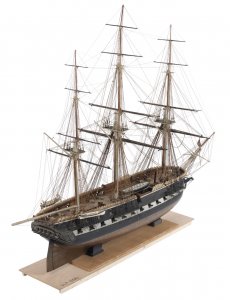






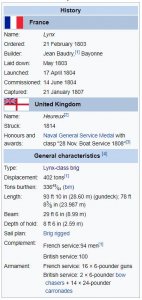



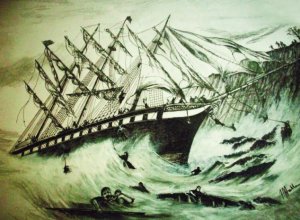
 paper accounts blamed the crew for negligence, but the official
paper accounts blamed the crew for negligence, but the official 